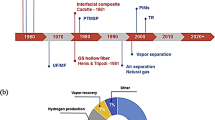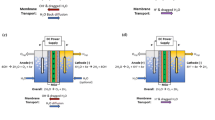Abstract
Fluorinated copolymers with different compositions and geometric structures have been prepared from 1-trimethylsilyl-1-propyne and its fluorinated containing analogue 1-(3,3,3-trifluoropropyldimethylsilyl)-1-propyne and then studied. The copolymers combine resistance to different hydrocarbons with high permeability coefficients and high selectivity of n-butane separation from its mixture with the noncondensable hydrocarbon methane. High microporosity of the copolymers is confirmed by the results of the determination of the pore volume and pore surface area using low-temperature sorption of nitrogen and the investigation of the film surface by atomic force microscopy (AFM). It has been found that microporosity, which determines the transport properties of the copolymers, depends on both their comonomer composition and the microstructure formed at the stage of polymer synthesis catalyzed by a certain catalyst system. In particular, the copolymers produced in the presence of a TaCl5–Ph3Bi catalyst have a greater pore size and a larger pore surface area relative to copolymers with a similar composition formed in the presence of the NbCl5–Ph3SiH system. The high values of gas transport parameters of the obtained copolymers and their selectivity for recovery of condensable hydrocarbons from vapor–gas mixtures together with resistance to higher hydrocarbons make these copolymers promising membrane materials, e.g., for use in natural gas conditioning processes or separation of C3+ hydrocarbons from associated petroleum gas.

Similar content being viewed by others
REFERENCES
J. Shultz and K.-V. Peinemann, J. Membr. Sci. 110, 37 (1996).
I. Rose and C. G. Bezzu, M. Cartaet al. Nat. Mater. 16, 932 (2017)
I. Pinnau and W. Koros, J. Appl. Polym. Sci. 43, 491 (1991).
M. Shiotsuki, F. Sanda, and T. Masuda, Polym. Chem. 2, 1044 (2011).
I. Pinnau and L. G. Toy, J. Membr. Sci. 116, 199 (1996).
Y. Shida, T. Sakaguchi, M. Shiotsuki, et al., Macromolecules 38, 4096 (2005).
Y. Shida, T. Sakaguchi, M. Shiotsuki, et al., Macromolecules 39, 569 (2006).
A. A. Kossov and V. S. Khotimskiy, Polymer 55, 989 (2014).
A. A. Kossov, A. A. Yushkin, V. S. Khotimskiy, and A. V. Volkov, Pet. Chem. 55, 783 (2015).
A. A. Kossov, K. Buhr, S. M. Shishatskii, et al., Polym. Sci., Ser. B 59, 452 (2017).
E. G. Litvinova, V. M. Melekhov, I. V. Petrushanskaya, et al., RU Patent No. 1 823 457 (1993).
A. A. Kossov, A. V. Rebrov, V. D. Dolzhikova, and V. S. Khotimskii, Polym. Sci., Ser. B 55, 258 (2013).
S. M. Matson, K. Ratzke, M. Q. Shaikh, et al., Polym. Sci., Ser. A 54, 671 (2012).
E. Yu. Sultanov, A. A. Ezhov, S. M. Shishatskiy, et al., Macromolecules 45, 1222 (2012).
ACKNOWLEDGMENTS
This work was performed under the state order of the Topchiev Institute of Petrochemical Synthesis, Russian Academy of Sciences, and was financially supported by the Federal Agency for Scientific Organizations of the Russian Federation. The experimental work on the determination of the parameters of permeability of the samples to gas mixtures was performed within the framework of the Agreement on the Cooperation between the Helmholtz-Zentrum Geesthacht (Germany) and Topchiev Institute of Petrochemical Synthesis, Russian Academy of Sciences. According to the Agreement, the financial backing of the cooperation is made out of the own resources of the participants of the Agreement.
Author information
Authors and Affiliations
Corresponding author
Additional information
Translated by E. Boltukhina
Rights and permissions
About this article
Cite this article
Kossov, A.A., Litvinova, E.G., Ezhov, A.A. et al. Copolymers of 1-(3,3,3-Trifluoropropyldimethylsilyl)-1-Propyne with 1-Trimethylsilyl-1-Propyne as Membrane Materials for Separation of Gas Mixtures Containing Hydrocarbons. Pet. Chem. 58, 1123–1128 (2018). https://doi.org/10.1134/S0965544118130066
Received:
Published:
Issue Date:
DOI: https://doi.org/10.1134/S0965544118130066




